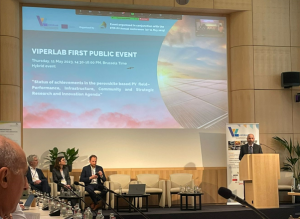
VIPERLAB Eerste openbare evenement op 11 mei 2023
Perovskiet PV heeft een enorm potentieel ten opzichte van conventionele zonnetechnologie. Zonnecellen op basis van perovskiet hebben in zeer korte tijd opmerkelijke vooruitgang geboekt met een snelle toename van de efficiëntie van ongeveer 3% in 2009 tot meer dan 33,7% nu voor een perovskiet/silicium tandemzonnecel op laboratoriumschaal. Perovskiet tandemzonnecellen raken in een stroomversnelling, zoals de Duitse kanselier Olaf Scholz onlangs benadrukte in het World Economic Forum 2023 in Davos, en worden nu ondersteund door een belangrijke gemeenschap en infrastructuur voor hun verdere ontwikkeling. Tot op de dag van vandaag voldoet de technologie echter nog niet aan de eisen voor massaproductie van modules op commerciële schaal, met name op het gebied van produceerbaarheid, duurzaamheid en stabiliteit.
In deze context was het VIPERLAB-evenement bedoeld om de huidige stand van zaken op het gebied van perovskiet te presenteren, evenals de belangrijkste barrières die moeten worden weggenomen om de grootschalige marktintroductie van perovskiet fotovoltaïsche energie (PV) te vergemakkelijken.
Het VIPERLAB-evenement werd geopend door Dr. Nader Akil, Operations Manager van PNO Innovation, projectpartner die de exploitatieactiviteiten in het VIPERLAB-project ondersteunt, die alle deelnemers welkom heette en de context en het concept van het evenement presenteerde.
Het evenement ging verder met een reeks presentaties, te beginnen met Dr. Natalia Maticiuc , VIPERLAB projectmanager bij Helmholtz-Zentrum Berlin (HZB). Als eerste stap en om het VIPERLAB-project beter te begrijpen, gaf ze een korte inleiding over de context, het concept, de doelstellingen en de impact. Het VIPERLAB-project, gesteund door 15 partners uit 9 landen, wil Europese academische en industriële onderzoekers stimuleren om samen te werken aan onderzoek en ontwikkeling (R&D) van de volgende generatie zonneceltechnologie, wat de ontwikkeling van perovskiet-PV-technologie in Europa zal versnellen. Tegenwoordig biedt het project de industrie en de academische wereld gratis toegang tot transnationale (verwerking en karakterisering) en virtuele infrastructuren van topniveau die betrokken zijn bij innovatieve materiaalsynthese, state-of-the-art apparaatontwerp en -ontwikkeling, gestandaardiseerde test- en simulatiemethoden.
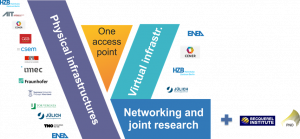
VIPERLAB infrastructuur en partners (VIPERLAB project)
Bovendien verzamelt het VIPERLAB-project een bredere perovskiet-PV-gemeenschap van onderzoekers en industrie die samenwerken aan netwerken en gezamenlijke onderzoeksactiviteiten. In een notendop, alle VIPLERAB infrastructuren, data, technische documenten en evenementen zijn gratis toegankelijk op het Knowledge Exchange Platform (KEP), Virtual Access Portal (VAPo) en VIPERLAB GATE platforms.
In dit kader heeft HZB een opmerkelijke vooruitgang laten zien in perovskiet zonnecellen en een snelle toename van hun efficiëntie in relatief korte tijd om een wereldrecord efficiëntie van 32,5% te bereiken tegen het einde van 2022. Om deze technologie echter van het laboratorium naar productieniveau te brengen, moeten veel technische problemen worden opgelost. Prof. Rutger Schlatmann, hoofd van de divisie Zonne-energie bij HZB en voorzitter van het European Technology and Innovation Platform PV, lichtte de nieuwste resultaten van Perovskite PV toe die door HZB zijn onderzocht. De eerste prestatie is gebaseerd op de materiaalkwaliteit en de omzettingsefficiëntie. Dit is de kerndoelstelling om verschillende tandemzonnecellen met hoog rendement te ontwikkelen, waarbij verschillende absorberende materialen worden gecombineerd en nieuwe apparaat concepten worden onderzocht. Ten tweede benadrukte Prof. Schlatmann het belang van opschaling en industrialisatie. Om deze beperkingen te overwinnen, ontwikkelt HZB schaalbare depositiemethoden zoals Slot-Die coating met N2-gasdoving, Co-evaporation en hybride methoden.
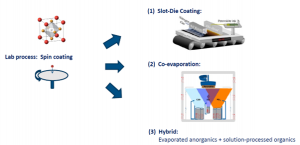
Routes voor het upscalen van perovskite (HZB)
Een derde onderwerp is de stabiliteit op lange termijn, die essentieel is voor zonnecellen op basis van perovskiet om concurrerend te worden met de huidige zonneceltechnologieën, maar die nog steeds in ontwikkeling is. Bovendien staat het duurzame profiel van perovskiet-PV ter discussie omdat de meest efficiënte perovskiet-zonnecellen gemaakt zijn van loodhalogenide zouten en dus potentieel toxische elementen zijn. De afgelopen jaren heeft HZB nieuwe materialen ontwikkeld met veelbelovende efficiëntie en stabiliteit, zoals CIGS*-Perovskiet tandem, silicium of organische perovskiet. Als resultaat hebben ze “een perovskiet-silicium tandemzonnecel met een gecertificeerd stroomomzettingsrendement van 29,15% en een perovskiet-CIGS tandemzonnecel met een gecertificeerd stroomomzettingsrendement van 24,16%” bereikt. Op basis van deze kernpunten en volgens Prof. Schlatmann “zijn er veel mogelijkheden voor de technologie om te gaan investeren”.
Om het marktperspectief van Perovskite PV beter te begrijpen, gaf de heer Philippe Macé, hoofd Strategie en Analytics bij Becquerel Institute (BI) een overzicht van de verschillende scenario’s. Het marktpotentieel is gebaseerd op de veelbelovende hoge efficiëntie van perovskieten en hun potentieel lage productiekosten, die deze technologie op een zeer snel marktgroeipad zouden kunnen brengen. Andere potentiële troeven zijn de hoge efficiëntie (>30% tegen 2050), de kleinere koolstofvoetafdruk in vergelijking met c-Si (kristallijn silicium), de opties voor vrije vormgeving en de mogelijkheid voor apparaten met een zeer laag gewicht.
Om deze studie uit te voeren, kwalificeerde het Becquerel Institute het marktpotentieel van perovskiet volgens een methodologie in vijf stappen, van de wereldwijde ontwikkeling van de PV-markt tot de marktpenetratie van perovskiet. Ten eerste, om de evolutie van de globale PV-markt tegen 2050 in te schatten, modelleerde BI de PV-markt met een logistische curve die de historische evolutie van de laatste 20 jaar volgt tot 20 TW gecumuleerd in 2050. Ten tweede schatten ze de evolutie van de PV-markt in per subsegment dat geschat werd op basis van gegevens uit het verleden, ontwikkelingspotentieel en kosten- en technische beperkingen. Als derde stap modelleerde BI ook de markttoegang van een nieuwe PV-technologie en toonde daarbij aan dat de jaarlijkse markttoegangscurve van perovskieten gelijk is aan die van voorgaande technologieën zoals Passivated Emitter and Rear Contact (PERC) zonnecellen, met een eerste commercieel product rond 2026 en een vertraging van 8 jaar tot de piek rond 2034. Bijgevolg heeft BI drie scenario’s voor markttoegang gedefinieerd, afhankelijk van de module-efficiëntie en de theoretische levensduur van perovskietmodellen die hun maximale penetratiegraad zullen beïnvloeden.
Samengevat is het marktpotentieel van perovskiet-PV sterk afhankelijk van het vermogen van deze technologie om haar beloften waar te maken op het gebied van kosten, efficiëntie en stabiliteit, die nog steeds ondermaats zijn. Op basis van de analyse van de drie scenario’s zal de penetratie van perovskieten op de PV-markt sterk afhangen van de behaalde prestaties, met jaarlijkse marktwaarden tussen 100 GW en 750 GW tegen 2050. Naast conventionele netgekoppelde fotovoltaïsche toepassingen zou de markt voor in voertuigen geïntegreerde fotovoltaïsche toepassingen (VIPV) ook een belangrijke bron van groei kunnen zijn voor perovskiet, waar lichtgewicht en esthetiek kunnen worden benut. Zoals de heer Macé zei: “de markt voor in voertuigen geïntegreerde fotovoltaïsche energie (VIPV) zal naar verwachting groeien met de ontwikkeling van e-mobiliteit en vormt dus ook een belangrijke bron van groei voor PV, inclusief voor perovskiet”.
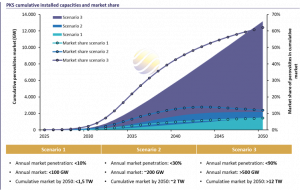
Analyse van PEROVSKIET potentieel door Becquerel Instituut
Op het gebied van O&O heeft Prof. Dr. Ivan Gordon, hoofd van de activiteiten fotovoltaïsche technologie en energiesystemen bij IMEC, de VIPERLAB Strategic Research and Innovation Agenda (SRIA) voor perovskiet enkelvoudige fotovoltaïsche energie geleid. Na verschillende discussies over een reeks workshops met belanghebbenden waren de belangrijkste uitkomsten:
- Noodzaak van meer nadruk op commercieel beschikbare perovskiet modules die zijn geproduceerd in Europa en die in overeenstemming zijn met de EU-veiligheidseisen (bijvoorbeeld in termen van Pb-gehalte) .
- De CO2-voetafdruk Key Performance Indicator (KPI) werd beschouwd als een van de belangrijkste differentiators in vergelijking met traditionele Si-PV.
- De Levelised Cost of Electricity (LCoE)-doelstelling werd onrealistisch geacht omdat hiervoor tegen 2030 op grote schaal perovskiet-PV-modules zouden moeten worden geproduceerd op een schaal die vergelijkbaar is met die van Si-PV, wat onwaarschijnlijk is.
Als gevolg hiervan werkt het VIPERLAB-project momenteel aan een Strategische Onderzoeks- en Innovatieagenda voor single-junction perovskiet fotovoltaïsche cellen op basis van de opmerkingen die tijdens de workshops zijn ontvangen. Dit heeft geresulteerd in de update van de KPI’s voor 2030, de prioritering van de benodigde activiteiten en de definitie van een duidelijk tijdschema en stappenplan om de KPI’s te behalen. De VIPERLAB SRIA zal in de komende maanden worden afgerond.
Hoe kan onderzoek en innovatie de ontwikkeling van perovskiet-PV in Europa stimuleren?
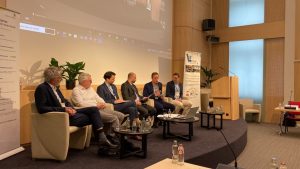
VIPERLAB evenement: paneldiscussie sprekers
Terugkijkend: 15 jaar geleden bevond een groot deel van de waardeketen voor de productie van zonnecellen op basis van silicium zich nog in Europa. Vandaag de dag is Europa deze waardeketen echter kwijtgeraakt, waardoor de Europese Unie afhankelijk is geworden van de invoer van zonnecellen uit derde landen. In deze context werd een paneldiscussie geleid door Dr. Akil, met deelname van verschillende beleids- en industriële vertegenwoordigers en experts op het gebied van PV en perovskiet, om de toekomstige productie van nieuwe zonnemodules in Europa te bespreken en welke barrières moeten worden weggenomen om dit doel te bereiken.
Eerst besprak Jaceck Truszczynski, plaatsvervangend hoofd van de Green and Circular Unit (DG GROW), hoe de European Solar Photovoltaic Industry Alliance, die in 2022 door de EC werd gelanceerd om de ontwikkeling van zonne-PV in de EU te versnellen door investeringen te vergemakkelijken, de versnelling van de sector minder risicovol te maken en de Europese doelstellingen voor het koolstofarm maken van de economie te ondersteunen, opkomende gemeenschappen en bedrijven zoals de perovskiet-PV zou kunnen ondersteunen.
De heer Truszczynski legde uit dat de Alliantie bedoeld is om veerkracht en strategische autonomie op te bouwen voor de Europese fotovoltaïsche waardeketen. Dit initiatief is opgezet ter ondersteuning van de doelstellingen van de EU-strategie voor zonne-energie, die tot doel heeft om tegen 2025 meer dan 320 GW fotovoltaïsche zonne-energie te produceren, wat meer dan een verdubbeling is van de productie in 2020, en bijna 600 GW tegen 2030. De alliantie is een forum voor belanghebbenden in de sector, gericht op het waarborgen van investeringsmogelijkheden voor Europese zon-PV’s en het helpen diversifiëren van de toeleveringsketens, het behouden van meer waarde in Europa en het leveren van efficiënte en duurzame PV-producten. Bovendien noemde de heer Truszczynski ook het laatste initiatief dat door de Europese Commissie is voorgesteld, de Net-Zero Industry Act (NZIA). Dit initiatief is bedoeld om de EU productiecapaciteit van net-nul technologieën te helpen versterken en belemmeringen voor het opschalen van de productiecapaciteit in Europa weg te nemen. Hij benadrukte dat “de NZIA de nodige voorwaarden zal scheppen om investeringen in projecten voor de productie van net-nul-technologieën te vergemakkelijken en projectpromotoren te ondersteunen bij het opbouwen van net-nul industriële productie”.
Vanuit het oogpunt van de industrie benadrukte Dr. Johan Lindahl, secretaris-generaal van de Europea Solar Manufacturing Council, dat “fotovoltaïsche energie in de nabije toekomst de grootste bron van elektriciteit zal zijn” en dat “vandaag dus de nieuwe olie wordt”. Deze uitspraak werd weerspiegeld in het feit dat landen zoals de Verenigde Staten (Inflation Reduction Act), India (importtarief) of China hun investeringen verhogen en nieuwe regelgeving goedkeuren om de ontwikkeling van hun PV-productiecapaciteit te ondersteunen. Daarom zet dit nieuwe internationale scenario de Europese beleidsmakers ertoe aan om ervoor te zorgen dat Europa in de toekomst weer een sterke PV-industrie heeft. Als prioriteit in een levensvatbaar scenario om deze doelen te bereiken, benadrukte Dr. Lindhal dat “Europa eerst de siliciumproductie moet opzetten om tandemzonnecellen te kunnen produceren” en niet achterop mag raken. Op dit moment zet Europa de eerste stappen om samen met de EU-lidstaten nieuwe regelgeving en subsidies op te stellen.
Tijdens het evenement werden ook harmonisatie- en standaardisatiethema’s besproken. Dr. Tony Sample, senior onderzoeker bij het EU’s Joint Research Center en standaardisatie-expert op het gebied van PV, gaf inzicht in de behoeften van een opkomende technologie zoals perovskiet om klaar te zijn voor industriële toepassing op het gebied van volwassenheid, testen en kwalificatienormen. Volgens Dr. Sample zijn “karakterisering, levensduur en typegoedkeuring” essentieel om het opschalingsproces van modules gemaakt van tandem-PV-cellen te versnellen. Daarnaast benadrukte Dr. Sample dat het voor het verbeteren van deze technologie erg belangrijk is om het degradatiemechanisme en de storingsmodi te analyseren van PV-modules die lange tijd in het veld zijn blootgesteld. Met betrekking tot geharmoniseerde metingen wees Dr. Stephan Abermann, hoofd van de Competence Unit Energy Conversion & Hydrogen aan het Oostenrijks Instituut voor Technologie, erop dat vanuit wetenschappelijk oogpunt “de grootste uitdaging vandaag de dag de grote verscheidenheid is aan materialen, apparaat concepten en fabricagemethoden die worden gebruikt in perovskiet-gebaseerde PV”. Hij benadrukte dat “harmonisatie op dit gebied moeilijk is vanwege de grote verscheidenheid aan metingen, apparaten en andere kenmerken die iedereen gebruikt”, wat veel uitdagingen met zich meebrengt voor onderzoek en ontwikkeling.
Alle sprekers waren het erover eens dat om de groei van perovskiet-PV in Europa te ondersteunen, de EU moet blijven investeren in onderzoek en innovatie om perovskiet-PV-technologieën te diversifiëren en op te schalen. Onderzoeksfinanciering moet zich richten op het opschalen van de PV-technologie en het verbeteren van harmonisatie- en standaardisatieprocessen. Het ondersteunen van de industrialisatie van deze technologieën zal ervoor zorgen dat Europa zijn technologisch leiderschap behoudt, zijn concurrentievermogen in een mondiale strategische sector vergroot en zijn klimaatdoelstellingen op de meest duurzame en co-effectieve manier realiseert.
Watch the full event here.
De conferentie in cijfers
Het VIPERLAB event, georganiseerd door PNO Innovation België in samenwerking met de VIPERLAB partners, trok een grote verscheidenheid aan stakeholders uit de industrie, de academische wereld, instellingen en organisaties. Het evenement werd georganiseerd in een hybride formaat en werd opgenomen voor de deelnemers aan de conferentie die niet konden deelnemen of voor andere geïnteresseerde stakeholders die niet online of ter plaatse aanwezig konden zijn.
In totaal schreven 104 mensen zich in voor het evenement en meer dan 70 namen ter plekke of online deel. De conferentie werd voornamelijk bijgewoond door vertegenwoordigers van de academische wereld (onderzoekscentra en universiteiten) met ongeveer 60% van de totale opkomst, terwijl deelnemers uit de industriesector goed waren voor bijna 33%. Het evenement werd ook bijgewoond door vertegenwoordigers van instellingen en organisaties, die 7% van de deelnemers vertegenwoordigden.
*CIGS staat voor koper indium gallium selenide (CuInxGa(1-x)Se2).



